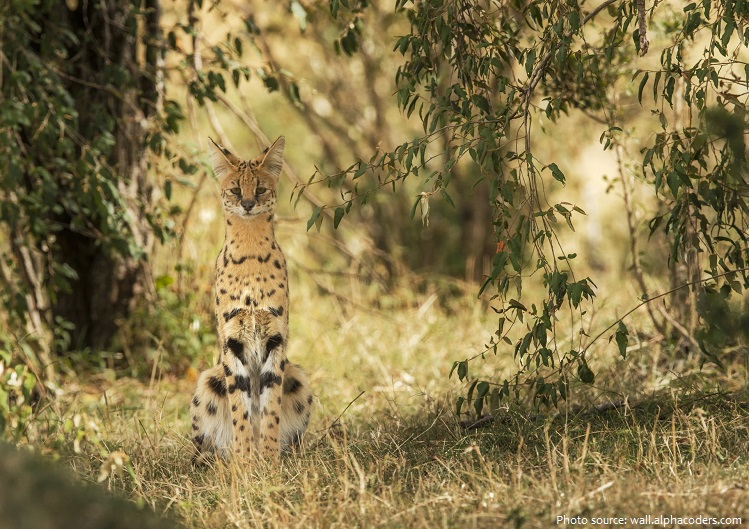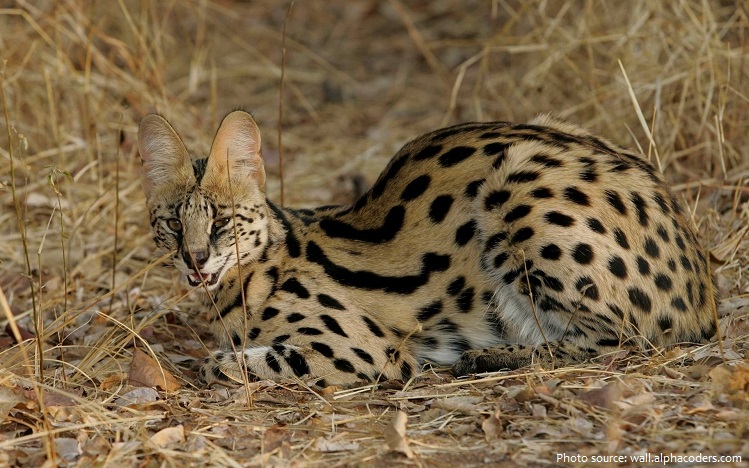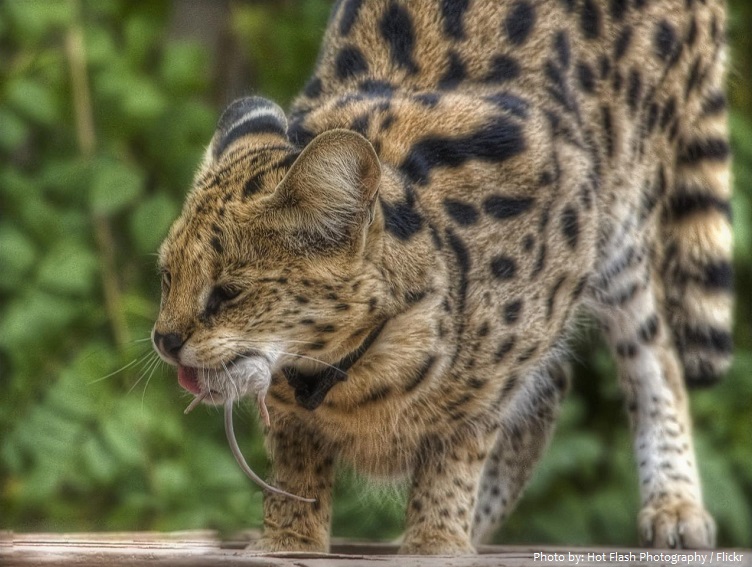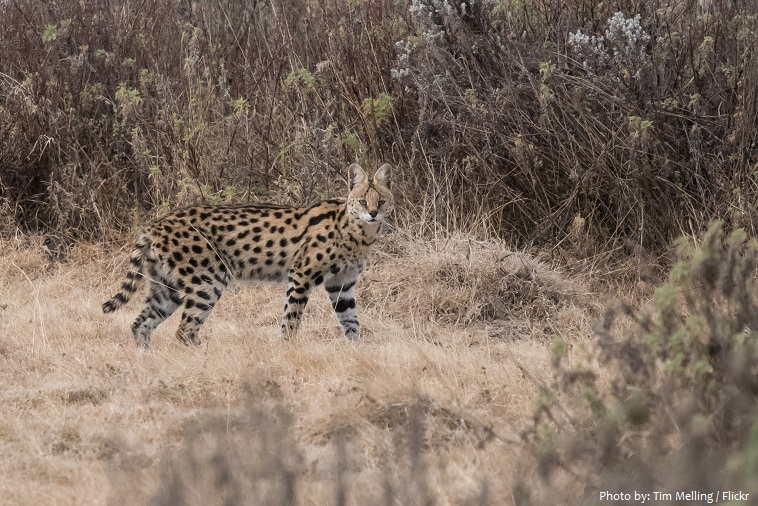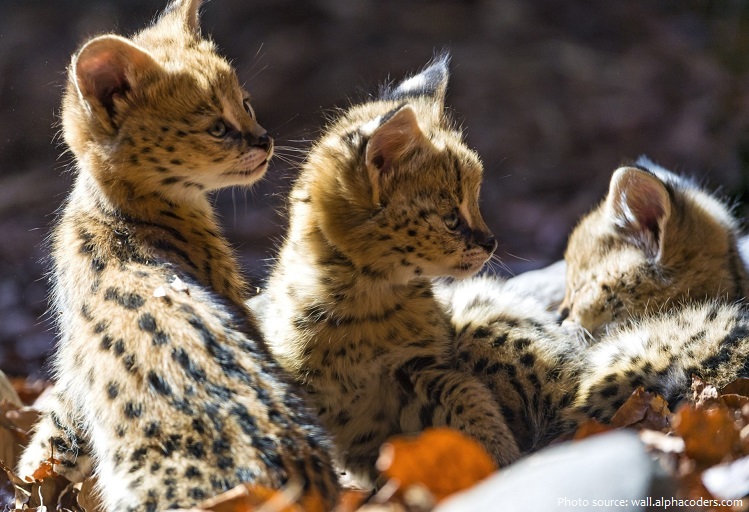The serval (Leptailurus serval) is a wild medium-sized cat native to Africa.
Servals are rare in North Africa and the Sahel, but widespread in sub-Saharan countries except rainforest regions.
Servals are found in several habitats. They are common on savannas where there is plenty of water. Servals prefer areas of bush, tall grass, and dry reed beds near streams, but they are also found in high-altitude moorlands and bamboo thickets. They are known to occur up to 3,800 meters (12,500 ft) above sea level on Mount Kilimanjaro.
The average lifespan for servals is about 10 years in the wild, and up to 20 years in captivity.
The serval stands 54 to 62 cm (21–24 in) at the shoulder and weighs 8 to 18 kg (18–40 lb). The head-and-body length is typically between 67 and 100 cm (26–39 in).
Serval are slender cats with long legs, a lean body, a short tail, and a small head.
Their legs and ears are long and considered the largest in the cat family relative to their size.
Facial features include the brownish or greenish eyes, white whiskers on the snout and near the ears.
The coat is basically golden-yellow to buff, and extensively marked with black spots and stripes. Three to four black stripes run from the back of the head onto the shoulders, and then break into rows of spots. The spots show great variation in size. The white underbelly has dense and fluffy basal fur, and the soft guard hairs.
Servals have excellent sense of smell, hearing and sight, which they use both for finding the prey and for avoiding predators.
Being a solitary animal, servals only interact with other members of their species when mating, caring for young, or fighting for territory.
With a combination of long, powerful legs, deep chest, and slim build allows the serval to reach a sustained speed of 80 km/h (50 mph).
The serval has a varied diet, eating rodents, birds, reptiles, frogs, fish, and large insects.
The serval has capability of leaping 3 meters (10 feet) in the air to catch birds and insects in flight. But small rodents are its most frequent prey item, and a serval doesn’t hesitate to reach a long leg down into a rodent’s burrow to snatch a meal out of the tunnel! Ultrasonic hearing ability allows the serval to hear the high-pitched communication of rodents. The cat’s long, curved claws can also hook fish and frogs right out of the water.
With its many hunting styles, varied diet, and fantastic hearing, the serval is well equipped to be the most successful predator of all the cats.
The serval is active in the day as well as at night; activity might peak in early morning, around twilight and at midnight. Servals might be active for a longer time on cool or rainy days. During the hot midday, they rest or groom themselves in the shade of bushes and grasses.
Like many cats, the serval is able to purr; it also has a high-pitched chirp, and can hiss, cackle, growl, grunt and meow.
The time when mating takes place varies geographically. The gestation period lasts around 74 days, after which the female normally gives birth to a litter of one to four kittens. When with young, the female is forced to spend considerably more time than usual hunting and consequently less time resting. After around a year, the female chases the young from the natal area but tolerate female offspring for a few months longer than males.
Servals have no major predators other than humans. Leopards and hyenas are the most probable competitors for food and territory. When African servals discover they are close to an individual of a rival species, they run away in confusing darting leaps.
The IUCN (International Union for Conservation of Nature and Natural Resources) lists the serval as least concern.
A major threat to the survival of the serval include the degradation of wetlands and grasslands.
Unlike many other cat species, servals love to climb, leap and play in water.
The name “serval” is believed to come from the Portuguese word lobo-cerval, meaning “lynx.”
Their extra-long neck and legs give them the nickname “giraffe cat.”
Servals with black coats are sometimes found in mountainous regions of East Africa.
The pelt of servals is valuable and used to make mantles worn by chiefs in native tribes.
The association of servals with human beings dates to the time of Ancient Egypt. Servals are depicted as gifts or traded objects from Nubia in Egyptian art.
Like many other species of felid, servals are occasionally kept as pets, although their wild nature means that ownership of servals is regulated in most countries.
One domestic cat breed, savannah, is a mix between tabbys and servals.
